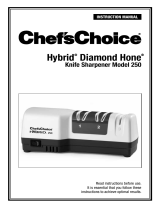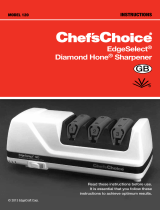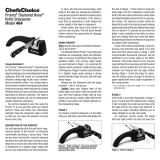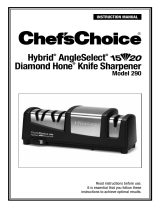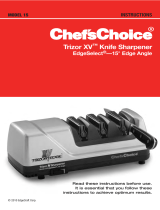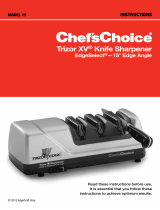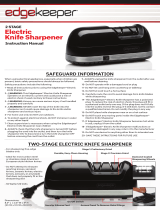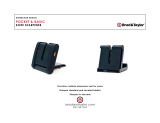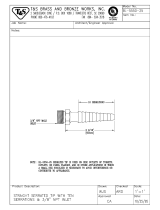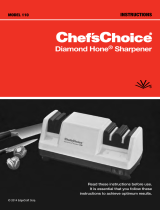Page is loading ...

MODEL 130
InstructIOns
Professional Sharpening Station
®
Read these instructions before use.
It is essential that you follow these
instructions to achieve optimum results.
© 2011 EdgeCraft Corp.

2
IMPORTANT SAFEGUARDS
When using electrical appliances, basic safety precautions should always be
followed including the following:
1. Read all instructions.
2. To protect against electrical hazards, do not immerse the Chef’sChoice
®
in water or
other liquid.
3. Make sure that only clean knife blades are inserted in the Chef’sChoice
®
.
4. Unplug from outlet when not in use, before putting on or taking off parts and
before cleaning.
5. Avoid contacting moving parts.
6. Do not operate any appliance with a damaged cord or plug or after the appliance
malfunctions, or is dropped or damaged in any manner.
U.S. customers: You may return your sharpener to EdgeCraft’s factory for service where
the cost of repair or electrical or mechanical adjustment can be estimated. If the
electrical cord on this appliance is damaged, it must be replaced by the Chef’sChoice
distributor or other qualified service to avoid the danger of electrical shock.
Outside U.S.: Please return your sharpener to your local distributor where the cost of
repair or electrical or mechanical adjustment can be estimated. If the supply cord
of this appliance is damaged, it must be replaced by a repair facility appointed by
the manufacturer because special tools are required. Please consult your
Chef’sChoice distributor.
7. CAUTION! This appliance may be fitted with a polarized plug (one blade is wider than
the other). To reduce the risk of electric shock, this plug will fit in a polarized outlet only
one way. If the plug does not fit fully in the outlet, reverse the plug. If it still does not fit,
contact a qualified electrician. Do not modify the plug in anyway.
8. The use of attachments not recommended or sold by EdgeCraft Corporation may cause
fire, electric shock, or injury.
9. The Chef’sChoice
®
Model 130 is designed to sharpen kitchen knives, pocket knives
and most sport knives. Do not attempt to sharpen scissors, ax blades or any blade that
does not fit freely in the slots.
10. Do not let the cord hang over edge of table or counter or touch hot surfaces.
11. When in the “ON” position (Red color on switch is exposed when “on”) the
Chef’sChoice
®
should always be on a stable countertop or table.
12. WARNING: KNIVES PROPERLY SHARPENED ON YOUR CHEF’SCHOICE
®
WILL BE SHARP-
ER THAN YOU EXPECT. TO AVOID INJURY USE AND HANDLE THEM WITH EXTREME
CARE. DO NOT CUT TOWARD ANY PART OF YOUR FINGERS, HAND OR BODY. DO NOT
RUN FINGER ALONG EDGE. STORE IN A SAFE MANNER.
13. Do not use outdoors.
14. Close supervision is necessary when any appliance is used by or near children.
15. Do not use honing oils, water, or any other lubricant with the Chef’sChoice
®
.
16. For household use only.
17.
SAVE THESE INSTRUCTIONS.

3
YOU MADE
A GOOD
CHOICE
P
rofessional chefs and serious cooks world-wide have for years relied on
Chef’sChoice
®
Diamond Hone
®
sharpeners to maintain high performance
edges on their favorite cutlery. Now with your Chef’sChoice
®
Professional
Sharpening Station
®
Model 130 you will share the professional’s advantage with
knife edges of astonishing sharpness and durability. The Chef’sChoice
®
Model 130
incorporates the latest sharpening technology developed by EdgeCraft, the world
leader in cutting edge technology, to create edges of better than factory sharpness
and performance on all of your fine-edge and serrated knives.
You will find the Model 130 extremely fast and simple to use. It is safe to use on
all brands and the highest quality kitchen, sporting and pocket knives. Please read
this instruction booklet thoroughly before using the sharpener to optimize your
sharpening results.
Gourmet cooks world-wide acknowledge the value of a fine cutting edge for
elegant food preparation. As an owner of the Chef’sChoice
®
Professional 130 you
have the means to sharpen, steel, strop and polish edges with a perfection, sharp-
ness and durability heretofore unobtainable with even the world’s most expensive
professional sharpening systems. You will find it is a joy to sharpen and use your
knives. The Chef’sChoice
®
Professional Sharpening Station
®
130 eliminates the
clutter of ineffective sharpening gadgets and provides in one compact appliance
the ultimate versatility of choosing the professional’s edge for any cutting task.
With the Chef’sChoice Sharpening Station
®
your knife edge will be astonishingly
sharp and long-lasting, no matter which type of edge you choose.
The Chef’sChoice
®
Model 130 Sharpening Station
®
creates demonstrably superior
multi-beveled edges on knives of any steel - carbon, stainless or alloy of any hard-
ness. Their resulting sharpness and greater durability clearly makes obsolete older
sharpening methods that produce conventional and hollow ground edges. You will
find it easy to quickly sharpen the entire cutting edge of your favorite knives, from
the tip to the handle or bolster.

UNDERSTANDING THE VERSATILE
CHEF’SCHOICE
®
SHARPENING STATION
®
MODEL 130
The unique Chef’sChoice
®
Sharpening Station Model 130 is designed to sharpen each knife
according to your intended use, whether it be gourmet food preparation, butchering, dress-
ing of game or filleting of fish. You can sharpen knives made with either straight or serrated
edges. This novel three (3) Stage Sharpening Station
®
has a precision conical disk sharpening-
stage with fine 100% diamond abrasives, a revolutionary precision steeling stage and a precise
polishing/stropping stage, which uses proprietary flexible abrasive disks. These stages can be
used in different sequences to give you either astonishingly sharp, smooth faceted edges for
effortless cutting and presentations or edges with a selected amount of “bite” along the facets.
You will find that such “bite” can aid substantially in the difficult chores of cutting fibrous foods,
meats, stalky vegetables, dressing of game or household chores such as cutting cardboard,
leather, carpet, etc.
The following sections describe the general procedures for optimal sharpening in each stage
and suggest how you can optimize the knife edge for your intended uses.
Unless you do a lot of heavy duty cutting you will need to use Stage 1 only infrequently.
One of the important advantages of using the Chef’sChoice
®
Professional Sharpening Station
®
is that you can steel and polish your knives to razor sharp edges as often as needed and yet
experience little knife wear compared to older sharpening methods.
Because the Professional Sharpening Station
®
is extremely versatile, you will quickly find
the perfect edge for each use. The Model 130 is, however, designed to easily create three of the
most popular but different edges as follows:
1. The Ultimate Fine Edge
To create an astonishingly sharp and durable edge – better than the conventional “factory-
edge” – you need use only Stage 1 and Stage 3. In this two step process the edge is first
sharpened with 100% diamonds and then gently stropped and polished with ultrafine abrasives
to hair-splitting sharpness, perfect for preparing decorative platters and for precision slicing of
more delicate foods.
2. Professionally Steeled Edge
The Sharpening Station incorporates the latest breakthrough from Chef’sChoice
®
– an easy
and precise method to steel the sharpened edge to a better than professional level. The edge is
first sharpened in Stage 1 and then steeled in Stage 2 at a highly precise and controlled angle
to create an exceptionally effective microscopically serrated (steeled) edge, the type preferred
by professionals for the more fibrous foods.
3. Steeled and Polished Edge
For those who prefer the ultimate steeled edge, the steeled edge prepared in Stages 1 and
2 can be given one quick pass on each side of the edge through Stage 3 to refine and further
enhance the sharpness of the steeled edge (See page 10).
The Professional Sharpening Station is equipped with a manually activated diamond dress-
ing pad that can be used, if necessary, to clean any accumulated food or sharpening debris from
the ultrafine abrasive surface of the Stage 3 polishing/stropping disks.
We strongly urge that you always thoroughly clean your knives before sharpening them. You
should go months or even a year or more before you need to dress these disks. Only if you
sense a distinct decrease in polishing efficiency in Stage 3 will there be any need to use this
convenient feature described further in a subsequent section.
4

The Sharpening Station (Figure 1) is equipped with elastomeric guide springs that are
positioned over each stage to provide a spring action that holds the face of your knife securely
against precision angled guide planes in the right and left slots of each stage. Unless you have
special blades designed to be sharpened primarily on one side of the edge (such as Japanese
Kataba blades), you will want to sharpen equally and alternately in the right and left slots of each
stage that you use. This will insure that the facets on each side of the edge are of equal size and
that the edge will cut straight at all times.
When sharpening in any stage the knife should, on sequential strokes, be pulled alternately
through the left slot and the right slot of that stage. Always operate the sharpener from the front
side (the power switch facing you). Hold the blade horizontal and level, slide it down between
the plastic spring and the guide plane and pull it toward you at a uniform rate as it contacts the
sharpening, steeling or stropping members. You will be able to feel and hear the contact as it
is made. Always keep the blade moving uniformly through each stage; do not stop your pull in
mid stroke. A consistent pull speed of about 4 seconds per stroke for an eight (8) inch blade is
recommended. The time can be less for shorter blades and more for longer blades.
Never operate the sharpener from the back side.
Use just enough pressure when sharpening or steeling to insure uniform and consistent
contact of the blade with the abrasive disks or miniature steel on each stroke. Additional pres-
sure is unnecessary and will not speed the sharpening process. Avoid cutting into the plastic
enclosure. However, accidental cutting into the enclosure will not functionally impact operations
of the sharpener or damage the edge.
Figure 1 below identifies each of the three stages as described further in the following sections.
INSTRUCTIONS
READ THIS BEFORE YOU START TO SHARPEN
The Chef’sChoice
®
Professional Sharpening Station
®
is designed to sharpen either Fine-edge or
Serrated edge blades and to steel Fine-edge blades.
Note: Sharpen Serrated Blades Only in Stage 3. See Section titled Procedure for
Sharpening Serrated Blades for more details.
PROCEDURE FOR CREATING THE ULTIMATE EDGE ON STRAIGHT EDGE BLADES
SHARPENING FOR THE FIRST TIME
Before you turn on the power, remove the cover positioned over Stage 1 and slip a knife blade
smoothly into the slot between the left angle guide of Stage 1 and the elastomeric spring.
5
Figure 2. Typical kitchen knife.
Heel
Bolster
Handle
Edge
Tip
Figure 1. Model 130 Professional Sharpening Station
®
.
Power
Switch
STAGE 1
Sharpening
STAGE 2
Steeling
STAGE 3
Stropping & Polishing
Elastomeric
Guide
Spring

Do not twist the knife (See Figure 3). (Retain the Stage 1 cover as a ready reminder of the
sharpening steps.) Move the blade down in the slot until you feel it contact the diamond disk.
Pull it towards you lifting the handle slightly as you approach the tip. This will give you a feel for
the spring tension.
Remove the knife and press the Power Switch. A red “indicator” on the switch appears when
this switch is turned “ON”.
Stage 1: Start in Stage 1. Pull the knife once through the left slot of Stage 1 (Figure 3) by
slipping the blade between the left angle guide and the polymeric spring while pulling the blade
toward you and simultaneously moving the blade downward in the slot until it engages the
diamond coated disk. You will hear it make contact with the disk. Insert the blade as close as
possible to its bolster or handle and pull it at a steady rate until it exits the slot. If the blade is
curved, lift the handle slightly as you sharpen near the tip of the knife, keeping the blade edge
approximately parallel to the table. Sharpen the entire blade length. For an eight (8) inch blade
each pull should take about 4 seconds. Pull shorter blades through in 2-3 seconds and longer
blades in 6 seconds. Next, repeat with one full length pull in the right slot of Stage 1.
Note: Each time you insert the blade you should simultaneously pull the blade toward you.
Never push the blade away from you. Apply just enough downward pressure to make contact
with the disk – added pressure does not modify or speed the sharpening process. Make an
equal number of pulls alternating in the left and right slots in order to keep the edge facets
symmetrical.
Except when you are sharpening for the first time in Stage 1 or if the blade is very dull, you
will find that one or two pairs of alternating pulls are adequate. Then after checking for a burr
on the edge as described below proceed to Stage 3. Stage 1 sharpening is considered complete
when a burr exists along one side of the edge.
Checking for the Burr After completing stage 1 you should confirm that a burr (see Figure
4) exists along one side of the edge. To check for the burr, move your forefinger carefully across
and away from the edge as shown in the Figures 4 and 5 (on page 7).
(Do not move your finger along the edge – to avoid cutting your finger). If the last pull was in
the right slot of Stage 1, the burr will appear only on the right side of the blade (as you hold it)
and vise versa. The burr, when present, feels like a rough and bent extension of the edge; the op-
posite side of the edge feels very smooth by comparison. If a burr exists, proceed to Stage 3.
If no burr exists, make one (1) additional pull in the left and right slots of Stage 1 before
proceeding to Stage 3. Slower pulls will help develop the burr. Confirm the presence of the burr
and only then proceed to Stage 3.
Figure 3. Stage 1. Inserting blade in slot between guide
and elastomeric spring. Alternate individual pulls in right
and left slots.
Burr
Figure 4. Develop a distinct burr along knife edge before
stropping in Stage 3.
6

Stage 3: In general only two pairs of pulls in Stage 3 will be necessary to obtain a razor sharp
edge. As in Stage 1, make alternate pulls in the left (Figure 6) and right slots, pulling the knife
through the slots at the same speed used in Stage 1.
More pulls in Stage 3 will refine the edge further, creating an edge particularly desirable for gour-
met preparations. Fewer pulls in Stage 3 may be preferable if you will be cutting fibrous foods.
Resharpening: Resharpen straight edge knives whenever practical using only Stage 3.
When that fails to quickly resharpen, return to Stage 1 and make one or two pairs of alternating
pulls. Then return to Stage 3 where generally only two alternating pairs of pulls will be adequate
to put a new razor-like edge on the knife. You will find it unnecessary to use Stage 1 as a first
step in resharpening unless the knife has been dulled excessively.
DRESSING OF STROPPING/POLISHING DISKS – STAGE 3
The Chef’sChoice
®
Professional Sharpening Station
®
is equipped with a built-in accessory to
manually clean/dress the stropping/ polishing disks in Stage 3. In the event these disks become
glazed with grease, food or sharpening debris, they can be cleaned and reshaped by actuating
the manual lever on the rear of the sharpener. This lever is located within a recess as shown
in Figure 7 on the lower left corner as you face the rear of the Sharpening Station. To actuate
the cleaning/ dressing tool, make sure the power is on and simply press the small lever in the
recess to the right or left and hold for 3 seconds. When the lever is moved in one direction, the
dressing tool cleans and reshapes the active surface of one stropping/ polishing disk. By next
moving in the opposite direction you clean the other disk.
Use this clean/dress accessory only if
and when Stage 3 no longer appears to be
stropping/polishing well or when it takes
too many pulls to obtain a razor sharp edge.
Using this tool removes material from the sur-
face of the Stage 3 disks and hence, if used
excessively, it will unnecessarily remove too
much of the abrasive surface – wearing the
disks out prematurely. If that should occur,
factory replacement of the disks will become
necessary. If you clean your knives regularly
before sharpening you should need to clean or
dress the Stage 3 disks only about once a year
or less frequently.
Figure 6. Inserting blade in left slot of Stage 3.
Alternate left and right slots.
Figure 7. Stage 3 disks can be cleaned if necessary.
Use infrequently. (See instructions).
7
Figure 5. Burr can be detected by sliding fingers across
and away from the edge. Caution! See text.
Move fingers
across and
away from
edge
Y

UNDERSTANDING THE PROFESSIONAL STEELED EDGE
With the Chef’sChoice
®
Professional Sharpening Station
®
you will for the first time be able to
experience the pleasure of cutting and slicing with perfectly steeled edges. You can in just sec-
onds create steeled edges with that extra “bite” and sharpness unmatched by even the most
experienced professionals.
The steeling Stage 2 contains a unique miniature steel made of a special high carbon steel
hardened to about Rockwell C-65 which is much harder than any commercially available cut-
lery. Consequently this special rod will show very little wear from repeated contact with the edge
as you steel your finest and hardest knives.
Precision knife guides in Stage 2 control and precisely align the face of the knife as the blade
is inserted into the slot between the guide and the blade retention spring (See figure 8). To use,
insert the blade alternately into the left and then the right slots and pull forward so that the knife
is held securely and the edge slides along the surface of the hardened miniature steel. When
steeling, it is not necessary to turn on the electrical power, however power is always needed
when using Stages 1 and 3.
The steel rod is supported by elastomeric materials that allow the rod to deflect when ex-
cessive force is applied to the blade. This feature and the ultra-precise and consistent angular
contact maintained stroke after stroke between the knife edge and the hardened steel rods are
key to optimizing the edge structure. Viewed under a microscope, the edge created by steeling
in Stage 2 presents a uniform formation of exceedingly fine and super-sharp micro-serrations.
Even after many uses and steeling of the knife edge, the original edge geometry is maintained
and the edge does not round-off like it would using a conventional manual steel, which has no
angle control.
Because of the consistent and precise angular control, Stage 2 maintains a shaving sharp
edge while it creates the uniform row of microscopic serrations along the knife edge. If the edge
is damaged when used for cutting, the Steeling Station will restore the edge micro-serrations
while maintaining the sharpness of the edge. This type of edge conditioning is unique to the
Sharpening Station.
At the top of the miniature steel rod is a slotted cap that accepts a coin or other tool so you
can rotate the steel rod slightly (one “click”) to expose a fresh area of the steel rod surface
(Figure 9). This is necessary only if the rod becomes sufficiently worn locally that the edge
conditioning process slows significantly. When the rod is rotated, fresh surfaces of the steel
are made available in both the left and right slots. A spring finger extends from the end of the
knife retention spring and clicks into a shallow groove in the cap on top of the steel rod. When a
Figure 8. Blade should be Steeled alternately in left and
right slots of Stage 2.
Figure 9. Rotating the steel with coin in slot.
8

new surface on the steel becomes necessary, rotate the slot counter-clockwise one click. By
this means, approximately 28 pairs of “steeling” areas are available over the lifetime of the rod.
Because the knife edge can be pulled over a given pair of areas on the rods several thousand
times before the wear affects the rate or precision of the edge formation, the rods will not need
to be rotated very often and they can last a lifetime with normal household use. Replacement
rods are, however, available from the EdgeCraft Corporation.
CREATING THE PROFESSIONAL STEELED EDGE
The steeled edge is created simply by first sharpening the blade normally in Stage 1 and then
steeling in Stage 2. The highly accurate angle guides in Stage 1 and Stage 2 are set at precisely
the optimum angles to insure rapid and full development of the steeled edge. Fine microscopic
serrations are consequently created in Stage 2 while maintaining the geometry and sharpness
created in the Stage 1 sharpening step.
Step 1. Sharpen the blade fully in Stage 1 as described in the preceding section and
summarized below:
a. Pull the blade slowly through the left slot of stage 1. Repeat by pulling the blade
through the right slot of Stage 1.
b. Repeat (a) above by pulling the knife again through the left and right slots of
Stage 1. Check the blade edge to insure a burr has been fully formed along the
entire edge (See figures 4 and 5). Then proceed to Step 2.
Step 2. Steel the edge in Stage 2.
Move the blade forward over the left slot of Stage 2 and insert it between the guide plane
and the blade retaining spring (See Figure 8) as close as possible to the bolster or handle. The
face of the blade should be in intimate contact with the guide plane. Pull the blade toward you
as you press down lightly on the blade so the edge makes good contact with the steel rod (NOTE:
The miniature steel rod is stationary and not powered). Make sure the edge maintains steady
contact with the steel rod from the handle to the tip of the blade. Repeat this procedure making
a full stroke in the opposite right slot between that guide and the spring. You should repeat this
motion making alternating pairs of pulls until the edge is fully conditioned.
You need make only about 10 pairs of alternating pulls to develop a good edge. Making
another 10 pairs of alternating pulls will further refine the edge and remove virtually all remnants
of the burr left from pre-sharpening. You will now find the knife cuts exceedingly well.
RESHARPENING THE STEELED EDGE
Whenever your knives appear to lose their “bite” or to be slightly dull, you can recondition
the edge to its prior performance with only about 10 pairs of alternating pulls in Stage 2. You
will need more pulls than that only if you have used the knife heavily for an extended time.
Resharpen the edge in Stage 1 when you feel it is taking too long (too many strokes) to
recondition the edge in Stage 2 to its initial performance.
Because you can reestablish the microstructure along the steeled edge of your knives
so easily and so many times before it will be necessary to resharpen the edge, you will find
your knives last longer. Conventional steels lacking angle control will, in most hands, create a
rounded and dull the edge after steeling the edge only a few times, making it necessary to
resharpen the edge frequently, thus reducing the useful life of the knife.
9

The Professional Sharpening Station
®
is not designed to steel the edge of serrated blades.
You can steel the single beveled Japanese Kataba type knives. However, because the edge on
one side of these knives is not beveled, you will optimize your results by applying slightly less
pressure when that side of the edge is being conditioned.
PROCEDURE FOR POLISHED STEELED EDGE
While the professional steeled edge prepared in Stages 1 and 2 as described above is very
sharp, it is possible to further enhance the edge sharpness with one very fast pull through the
stropping disks of Stage 3. Because the sharpening angles of Stages 2 and 3 are very close, the
microserrations can be slightly polished in Stage 3 without removing the serrations. However
the stropping action of Stage 3 will remove the microserrrations if the contact time in Stage 3 is
too great. By making one fast (2 seconds) pull thru the left slot followed by one fast (2 seconds)
pull thru the right slot in Stage 3 you can simply enhance or “polish” the steeled edge.
Caution: If you make slower or more pulls thru Stage 3 you will remove completely the
microscopic serrations developed during steeling in Stage 2. In that event, resharpen again in
Stage 1 to develop a full burr along the edge and repeat the steeling steps in Stage 2.
Resharpening the Steeled and Polished Edge: Steel in stage 2 with 10 pairs of alternating
pulls. Every second or third time you find it necessary to steel your knives, follow the steeling
with one (1) very fast pair of alternating pulls in Stage 3.
PROCEDURE FOR SHARPENING SERRATED BLADES
Serrated blades are similar to small saw blades with scalloped depressions and a series of
pointed teeth. In normal use the pointed teeth do most of the cutting.
Serrated blades of all types can be sharpened in the Chef’sChoice
®
Model 130. However, use
only Stage 3 (Figure 10), which will straighten, realign and sharpen the teeth of the serrations
and develop microblades along the edge of these teeth. Generally five (5) to ten (10) pairs of
alternating pulls in Stage 3 will be adequate. If the knife is very dull more pulls will be needed.
Because serrated blades are saw-like structures, the edges will never appear to be as
“sharp” as the edge on a straight edge knife. However, their tooth-like structure will help
break the skin on hard crusty foods and penetrate other materials such as cardboard.
TEST FOR EDGE SHARPNESS
To test periodically for sharpness and cutting ability of your fine edge or steeled edge hold a
sheet of paper by the edge and carefully cut the sheet a small (but safe) distance from your
finger. A sharp edge will cut smoothly without tearing the paper.
Alternatively try cutting a tomato. The knife should pierce through the skin of the tomato and
cut through it on the first pull without significant force applied to the knife. This is also a good
test for serrated blades.
Figure 10. Sharpen serrated blades only in Stage 3.
(See instructions).
10

SUGGESTIONS
1. Always clean all food, fat and foreign materials from knife before sharpening or
resharpening. If soiled, wash the blade before sharpening.
2. Use only light downward pressure when sharpening – just enough to establish secure
contact with the abrasive disk.
3. Always pull the blade at the recommended speed and at a constant rate over length of blade.
Never interrupt or stop the motion of the blade when in contact with the abrasive disks.
4. Always alternate pulls in right and left slots (of any stage used). Specialized Japanese blades
are an exception and are sharpened primarily on one side (beveled side) of the blade.
5. The edge of the knife blade, while sharpening, should be held in a level position relative
to the top of the counter or table. To sharpen the blade near the tip of a curved blade, lift
the handle up slightly as you approach the tip so that the edge, as it is being sharpened, is
maintained “level” to the table.
6. Used correctly, you will find you can sharpen the entire blade to within
1
/8” of the bolster
or the sharpener handle. This is a major advantage of the Chef’sChoice
®
Model 130 com-
pared to other sharpening methods – especially important when sharpening chef’s knives
where you need to sharpen the entire blade length in order to maintain the curvature of the
edge line. If your chef’s knives have a heavy bolster near the handle extending to the edge,
a commercial grinder can modify or remove the lower portion of the bolster so that it will
not interfere with the sharpening action, allowing you to sharpen the entire blade length.
7. To increase your proficiency with the Chef’sChoice
®
Model 130, learn how to detect a burr
along the edge (as described previously). While you may be able to sharpen well without
using this technique, it is the best and fastest way to determine when you have sharpened
sufficiently in Stage 1. This will help you avoid over-sharpening and insure incredibly sharp
edges every time. Cutting a tomato or a piece of paper is a convenient way of checking for
blade sharpness.
8. Do not attempt to use the Professional Sharpening Station
®
to sharpen or steel either
ceramic knives or scissors.
9. You will find that you can sharpen to better than factory sharpness or put a steeled edge on
a variety of your metal knives regardless of brand including, Wüsthof, Henckels, Sabatier,
Chicago Cutlery, Lamson and Goodnow, Global, Russel Harrington, Forshner, Chef’sChoice,
Messermeister, Mundial, Viking, Cuisinart, Kitchen Aid and many, many more.
10. Keep your fingers clear of the blade edge at all times.
NORMAL MAINTENANCE
NO lubrication is required for any moving parts, motor, bearings or sharpening surfaces. There
is no need for water on abrasives. The exterior of the sharpener may be cleaned by carefully
wiping it with a soft, damp cloth. Do not use detergents or abrasives.
Once a year or so as needed, you can remove metal dust that will accumulate inside the
sharpener from repeated sharpenings. Remove the small rectangular clean-out cover that
covers an opening on the underside of the sharpener. (See Figure 11). You will find metal
11

particles adhered to a magnet attached to the
inside of that cover. Simply rub off or brush
off accumulated filings from the magnet with
a paper towel or tooth brush and reinsert the
cover in the opening. If larger amounts of metal
dust have been created or if the Stage 3 disk
has been cleaned (using the cleaning/dressing
tool) you can shake out any remaining dust
through the bottom opening when the cover
is removed. After cleaning, replace the cover
securely with its magnet in place.
SERVICE
In the event post-warranty service is needed, return your sharpener to the EdgeCraft factory
where the cost of repair can be estimated before the repair is undertaken. Outside the USA,
contact your retailer or national distributor.
Please include your return address, daytime telephone number and a brief description of the
problem or damage on a separate sheet inside the box. Retain a shipping receipt as evidence of
shipment and as your protection against loss in shipment.
Assembled in the U.S.A. www.chefschoice.com
This product may be covered by one or more EdgeCraft patents and/or patents pending as marked on the product.
Chef’sChoice
®
, EdgeCraft
®
, Diamond Hone
®
, Professional Sharpening Station
®
and the overall design of this
product are registered trademarks of EdgeCraft Corporation, Avondale, PA.
Conforms to UL Std. 982 Certified to CAN/CSA Std. C22.2 No. 64
Certified to EN 60335-1, EN 60335-2, EN 55014-1+A1, EN 61000-3-2, EN 61000-3-3
© EdgeCraft Corporation 2011 Printed in China.
H11 2011-44 C139603
®
EdgeCraft Corporation
825 Southwood Road, Avondale, PA 19311 U.S.A.
Customer Service (800) 342-3255 or 610-268-0500
12
Figure 11. Clean-out cover.
/
